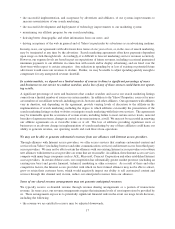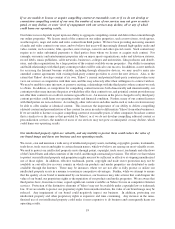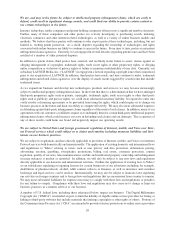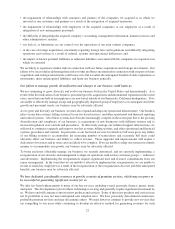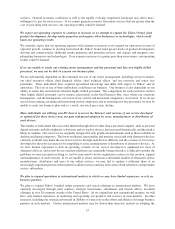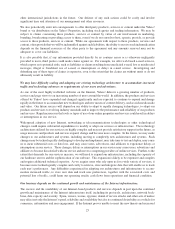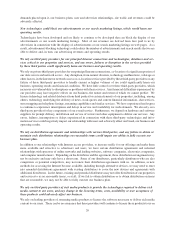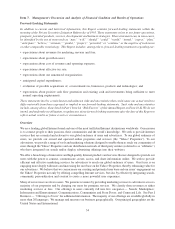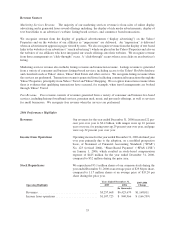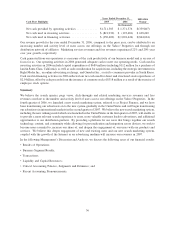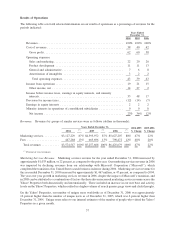Yahoo 2006 Annual Report Download - page 37
Download and view the complete annual report
Please find page 37 of the 2006 Yahoo annual report below. You can navigate through the pages in the report by either clicking on the pages listed below, or by using the keyword search tool below to find specific information within the annual report.reasonable terms, or at all. Our users are currently able to electronically download copies of the software to play
rich media free of charge, but providers of rich media products may begin charging users for copies of their player
software or otherwise change their business model in a manner that slows the widespread acceptance of these
products. In order for our rich media services to be successful, there must be a large base of users of these rich media
products. We have limited or no control over the availability or acceptance of rich media software, and to the extent
that any of these circumstances occur, our business may be adversely affected.
If we fail to prevent click fraud or if we choose to manage undesirable clicks in a way that advertisers find
unsatisfactory, we could lose the confidence of our advertisers as well as face potential litigation, which
could adversely impact our business and profitability.
We are exposed to the risk of click fraud or other clicks that advertisers may perceive as undesirable. If fraudulent
activity occurs and we are unable to detect and prevent it, or if we choose to manage undesirable clicks in a way that
advertisers find unsatisfactory, the affected advertisers may experience or perceive a reduced return on their
investment in our advertising programs which could lead the advertisers to become dissatisfied with our advertising
programs. This could damage our brand and lead to a loss of advertisers and revenue. Advertiser dissatisfaction has
led to litigation alleging click fraud and could potentially lead to further litigation. We may also issue refunds or
credits as a result of such activity. Any increase in costs due to any such litigation, refunds or credits could
negatively impact our profitability.
Interruptions, delays or failures in the provision of our services could damage our brand and harm our
operating results.
Our operations are susceptible to outages and interruptions due to fire, floods, power loss, telecommunications
failures, cyber attacks, terrorist attacks and similar events. In addition, a significant portion of our network
infrastructure is located in Northern California, an area subject to earthquakes. Despite our implementation of
network security measures, our servers are vulnerable to computer viruses, worms, physical and electronic break-
ins, sabotage and similar disruptions from unauthorized tampering with our computer systems. For example, we are
vulnerable to coordinated attempts to overload our systems with data, resulting in denial or reduction of service to
some or all of our users for a period of time. We have experienced a coordinated denial of service attack in the past,
and may experience such attempts in the future. We do not have multiple site capacity for all of our services and
some of our systems are not fully redundant in the event of any such occurrence. In an effort to reduce the likelihood
of a geographical or other disaster impacting our business, we have distributed and intend to continue distributing
our servers among additional data centers located around the world. Failure to execute these changes properly or in
a timely manner could result in delays or interruptions to our service, which could result in a loss of users and
damage to our brand, and harm our operating results. We may not carry sufficient business interruption insurance to
compensate us for losses that may occur as a result of any events, which cause interruptions in our service.
We may be required to record a significant charge to earnings if our goodwill, amortizable intangible assets
or investments in equity interests become impaired.
We are required under generally accepted accounting principles to review our amortizable intangible assets and
investments in equity interests for impairment when events or changes in circumstances indicate the carrying value
may not be recoverable. Goodwill is required to be tested for impairment at least annually. Factors that may be
considered a change in circumstances indicating that the carrying value of our amortizable intangible assets may not
be recoverable include a decline in stock price and market capitalization, and slower growth rates in our industry.
Factors that may be considered a change in circumstances indicating that the carrying value of an investment in
equity interest may not be recoverable include a decline in the stock price of an equity investee that is a public
company or a decline in the operating performance of an equity investee. We may be required to record a significant
charge to earnings in our consolidated financial statements during the period in which any impairment of our
goodwill, amortizable intangible assets or investments in equity interests is determined. This would adversely
impact our results of operations.
27


